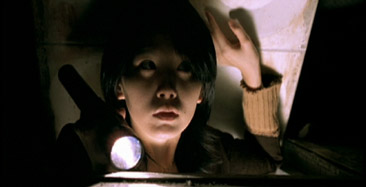|
Followers
of Far Eastern horror cinema are well used to seeing the form's ideas
stolen and regurgitated, initially by Hollywood but increasingly
also by the very countries that gave birth to the works
being pilfered from. We genre fans learn to tolerate quite
a bit, but Lim Chang-jae's Unborn
but Forgotten [Hayanbang] really
pushes its luck. It's essentially a Korean reworking of FeardotCom, William Malone's tawdry beat-the-official-remake-to-the-post
retooling of Nakata Hideo's seminal 1998 Ringu,
which has already been remade in Korea in 1999 as Ring
Virus. The passing of time has not helped matters,
with the plundering from the Ringu pot
becoming increasingly a sign that the ideas bank has run
dry.
Lim
makes no attempt to disguise the borrowings and little effort
to develop them in any meaningful way. Consider the following. In Ringu,
young female TV journalist Reiko Asakawa investigates a
series of mysterious deaths involving young people who expired
a few days after watching a supposedly haunted video tape.
In Unborn But Forgotten, young female TV
producer Han Su-jin investigates a series of mysterious
deaths involving pregnant women who expired a few days after
visiting a strange web site. In Ringu the
ante is upped when Reiko herself sees the video tape and
the phone immediately rings, signifying that her time too
may soon be up. In Unborn But Forgotten the
ante is upped when the pregnant Su-jin clicks on the mysterious
web site and starts having visions, signifying that her
time may soon be up. In Ringu, Reiko enlists
the help of her ex-husband and the two find themselves in
a race to uncover the secret of the tape before she falls
victim to its curse. In Unborn But Forgotten,
Su-jin enlists the help of detective Choi and the two find
themselves in...well, you get the idea.

Despite
this rather precise recycling, the development is plodding
and lacks the the screw-turn provided in Ringu
when the tape is also viewed by Reiko's young son, as well
as Nakata's enviable skill at storytelling and building atmosphere.
And despite a couple of half-effective moments, the scares
just aren't that scary, and in the case of the closed-eye
doll that suddenly opens its eyes, both predictable and old-hat. The nearest
the film came to even giving me the smallest of creeps was
when Su-jin ventures into an attic crawlspace with only
a torch for illumination, the sort of restricted-vision
wandering into the unknown that always winds me up a little.
I've
seen three Asian horror movies in the past week (all released
under Tartan's Asian Extreme banner) and all are guilty
of various degrees of pilfering, but at least Inner
Senses and Cello
had ideas of their own and were smartly enough made to prompt a degree of forgiveness. Unborn But Forgotten
doesn't so much borrow as rip right off, and not just from Nakata's
and Malone's films either – hints of The Others,
It's Alive and even The Shining
are not too hard to spot, while the style of the opening
title sequence has been blatantly diluted from David Fincher's
Se7en. Asian horror completists will want
to add it to their viewing list nonetheless, but they are
likely to find that this time they really have seen it all
before.
The
1.85:1 anamorphic transfer here is in some ways typical
of how Far Eastern horror too often looks on UK DVD – not
bad, but not great. Colour is slightly off in places,
sharpness loses out a tad to grain, there is some occasional
edge and pattern shimmering, and the contrast is sometimes
on the heavy side, resulting in a loss of shadow detail,
some of which may be down the NTSC to PAL conversion. Slightly
more curious is the occasional feeling that the picture
is slightly squashed up vertically – this struck me more
than once, but on checking circles (when they did appear)
they generally seemed fine.
Of
the three available soundtracks – stereo 2.0, 5.1 surround
and DTS surround, all original Korean – it's the surround
tracks that work best, with the expected musical shouts
of "Boo!" considerably louder here, and the atmospheric
effects and music more inclusive. The surrounds are not
used to the degree they are in some Asian horrors.
On
the Set (59:23) is a lengthy assembly of behind-the-scenes
footage, stuck together without any real eye for structure
or ear for sound continuity. I find any such footage interesting,
but the formless and rambling nature of this one does make
you yearn for it to be handed to an editor who would probably
have cut it down to about ten useful minutes and begged
the director and actors to actually go on camera to talk
about what they were doing. Most of the dialogue is subtitled
in English.
The
Original Korean Trailer (1:43) is in slightly grubby shape
and cheekily uses the term "Something New" to
describe a product that is anything but.
Not
much to say here, another mediocre rip-off of one of the
defining films in modern horror on a distinctly average
DVD. You've been warned.
|